Energy security, including the uninterrupted availability of energy sources to military units and industry, directly impacts U.S. national security. The Biden Administration is pushing aggressively for a rapid transition to alternative “green” energy in both the public and private sectors, including the Department of Defense (DOD). For the foreseeable future, however, military forces employing ships, planes, and combat vehicles, as well as significant components of defense infrastructure, will be dependent on an affordable, abundant, and dependable supply of petroleum and the electricity produced by fossil fuels.
The U.S. government needs to pursue a more resilient framework of international partnerships and agreements, as well as to facilitate domestic production, refining, and transport to ensure access to critical fuels for defense needs in the event of a prolonged military conflict with a near-peer adversary such as the People’s Republic of China, which faces acute energy vulnerabilities of its own and may well be complicit in the drive to transition the U.S. military to renewable energy.
This is the second paper in The Heritage Foundation’s “Chinese Handcuffs” series on the perils of overreliance on Chinese renewable energy and a misguided environmental agenda.REF Key recommendations include:
- Ensure that the U.S. military has secure and readily available traditional energy for a prolonged war with China by rethinking the role and management of the Strategic Petroleum Reserve.REF
- Build America’s capacity to meet and sustain national energy needs in the transition from crisis to major war by unshackling domestic refiners, tapping into vast domestic energy reserves, and removing barriers so that to U.S. energy can be connected more readily to where it is needed.
- Strengthen energy trade relationships with allies and partners to ensure America’s access to markets while enhancing energy resilience.
U.S. Military’s Reliance on Conventional Fuels
America’s transportation sector (trucking, rail, shipping, etc.) depends on gasoline, diesel, jet fuel, and other conventional fuels for over 90 percent of its energy needs.REF This is not likely to change anytime soon. In the transportation sector, for example, over 11 million commercial vehicles registered in the U.S. are diesel powered, including 97 percent of large “highway tractor-trailer size trucks.”REF The DOD’s ill-advised attempt to shift its 170,000 nontactical-vehicle fleet to electric power remains a long-term endeavor.
In the post–Cold War era, the U.S. military has become accustomed to moving critical repair parts on commercial carriers. As a consequence, these parts are vulnerable to coercion and political interference from hostile nations, including hostile actors that might threaten the military’s access to energy. In 2018, commercial carriers moved 90 percent of military personnel and 40 percent of material shipments.REF In addition, without sufficient fuel, the American economy would be significantly slower, which in turn would entail dire consequences for military operations that must rely on a functioning domestic industry and logistics network.REF This problem would be especially serious during a prolonged war with China.
Deliberate policy planning and investments are needed to ensure that the U.S. can sustain prolonged military operations. This is especially true for scenarios in which a major war disrupts overseas energy markets and normal shipping methods. Under such conditions, the U.S. will need more diverse and reliable overseas suppliers for military operations. Given the global impact that a war with China would have, the U.S. urgently needs to ensure that it has enough fuel stocks and crude oil to allow it time to adjust to a wartime footing.
The U.S. government must take into consideration the time it takes to reconfigure existing refineries (years) or build new refineries (a decade) to meet wartime demand that cannot be securely sourced overseas. Importantly, the U.S. government also must ascertain the domestic refining capacity necessary to sustain many months of intense combat operations and wartime industrial activity with limited overseas access to refined petroleum products.
“Energy independence” for America would be a significant and costly challenge, but maximizing the potential output of domestic energy sources needs to be a policy priority. In the past, the U.S. has relied on global oil markets to meet surges in domestic demand, but overseas access to markets could be constrained during a war with China.
Peacetime Military Needs Only a Fraction of Wartime Energy Requirements
Between 2015 and 2020, the U.S. military consumed, on average, 93 million total barrels of fuel annually to sustain its operations.REF Almost half of this fuel was purchased from foreign sources to sustain deployed units.REF Military units based or operating in overseas locations typically purchase fuel from local distributors on the open market and through agreements with host nations.REF While small relative to total national consumption—military consumption has averaged 1.3 percent of national consumption since 2020—overseas consumption for military operations obscures the burden it could place on domestic transportation and energy suppliers if called to sustain wartime operations.REF More specifically, the military’s primary needs would focus on refined crude oil in the forms of diesel, motor gasoline, and jet fuel.
To power logistic ships, trucks, and heavy equipment in fiscal year (FY) 2023, the Defense Logistics Agency (DLA), which is responsible for the military’s operational energy needs, purchased 79.5 million barrels of petroleum, which includes 16.8 million barrels of diesel fuel.REF Jet fuel, consisting of varying grades, is used to power aircraft as well as modern naval warships using gas turbines.REF This represents the largest military operational energy need, which has required an average of 60.6 million barrels a year since 2018.REF Military requirements for motor gasoline for this same time frame averaged 1.2 million barrels a year.REF
Due to a heavy reliance on foreign sources, poor policy choices, and constraints on the transport of fuels, the U.S. military could be vulnerable. The risk is for localized fuel shortages, global supply disruptions, and Chinese economic coercion during a conflict driving significantly increased energy demands.
Wartime Fuel Needs and Domestic Supply
To sustain military wartime operations, as of April 30, 2024, the Maritime Administration (MARAD), which is an agency within the U.S. Department of Transportation, maintained or contracted for 87 vessels of varying classes as a National Defense Reserve Fleet.REF This was augmented as of January 17, 2024, by 60 additional commercially active but militarily useful vessels that can be called on under terms of the Maritime Security Program.REF This domestic fleet is woefully inadequate to sustain a nation at war. Moreover, the average age of these merchant ships is 45 years, well over the industry end-of-life average of 20 years, and DOD faces a gap of approximately 76 fuel tankers that would have to be filled to meet wartime sealift requirements.REF
In practice, the MARAD fleet is intended to move fuel and materials, such as ammunition, to support combat operations. In a major prolonged war with China, this small fleet would be unable either to meet combined military operational needs or to sustain a wartime economy. At the same time, this fleet would have to compete for tightening diesel fuel supplies, as U.S.-flagged vessels are overwhelmingly propelled by diesel fuel.REF
Moreover, if a conflict with China were to erupt, maritime trade would likely experience significant disruptions, thereby forcing the military to rely on fuel stockpiles for at least a period of time. In the early months of a potential conflict, the most pressing concern would be the potential loss, under Chinese threat, of overseas suppliers that the peacetime military has grown accustomed to using. To mitigate such shocks, the military currently stockpiles fuel at strategically important locations, such as the Red Hill Bulk Fuel Storage facility in Hawaii. Due to years of neglect, that facility has been shut down, and replacements have yet to be found.REF
Without adequate fuel reserves and the ability to move fuel to the ships and aircraft using it, the U.S. military is in a potentially precarious position. How extensive the problem of competing demands for fuel between civilian and industry needs and wartime operational needs would be in the event of a conflict with China is unknown, although the Strategic Petroleum Reserve would ostensibly ease the energy sector’s transition to a war footing.
Strategic Petroleum Reserve’s Role Needs an Update
The Strategic Petroleum Reserve (SPR) was established by Congress in 1975 to mitigate energy shocks such as the oil crises of the 1970s and is mandated to hold a 90-day reserve of crude oil, which is not based on wartime usage.REF Four sites for the storage of crude oil are located in Texas and Louisiana and have a combined capacity of 714 million barrels.REF Since 2015, Congress has enacted seven bills mandating sales by FY 2028 of up to 271 million barrels of crude oil from these reserves.REF This was based on imports of crude oil narrowing as domestic production rose, making larger reserves seemingly unnecessary.
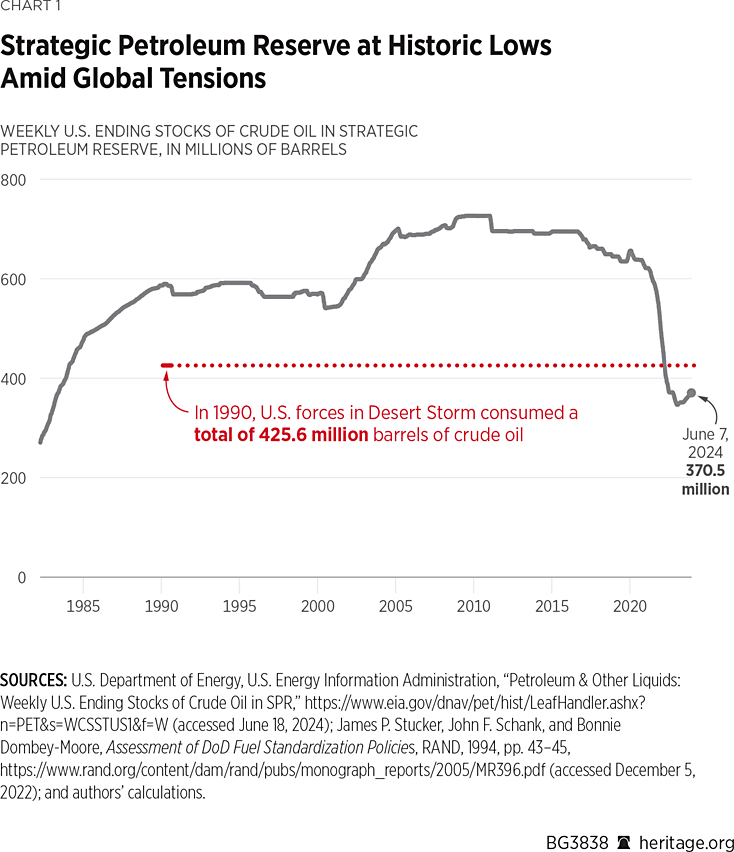
Notably, while most of America’s domestic oil reserves consist of light crude oil, American refineries are predominantly tuned to process heavy crude oil because of market decisions made to invest in refineries that were processing heavy crude before American shale oil became profitable in the past decade. Because American refineries are so calibrated, the U.S. imports significant amounts of heavy crude oil while exporting domestically produced light crude.REF America’s refineries can still refine light crude but at a lower production rate.REF
Another factor driving U.S. energy imports is utilization of the most economically accessible refined products. New England, for example, relies on nearby and cheaper Canadian-refined petroleum.REF As Susan Grissom of the American Fuel and Petrochemical Manufacturers has noted, “U.S. refining capacity is already sufficient to produce enough product to meet U.S. demand—it’s just not produced in the region where it’s needed and there isn’t transportation infrastructure to move it economically.”REF For these reasons, the SPR and America’s crude refining capacity by themselves cannot minimize the risks to accessing and transporting U.S. fuel. Actions are needed to ensure that adequate crude is available and can be refined at the rates needed for a wartime economy and military with associated ability to move those fuels where needed.
Making matters worse is the temptation to tap the SPR for political purposes. President Joe Biden’s decision to tap the SPR in 2022 and release 180 million barrels ahead of midterm elections dropped inventories by almost one-third in an attempt to reduce prices at the pump.REF The decision came at a time when private inventories were dropping precipitously, leaving little surge capacity for a crisis. On November 8, 2022, the Energy Information Administration (EIA), an agency within the U.S. Department of Energy, estimated that distillate fuel inventories (fuel used in trucks, heavy equipment, and heating) in the U.S. had reached “the lowest end-of-October level since 1951” and forecasted that inventories in 2023 would be “17% below the five-year average.”REF By early 2024, these inventories appeared to have stabilized as the American economy slowed.REF
Given the high price of replacing the low-cost barrels released by the Biden Administration, SPR reserves have not moved much since then. As of January 2024, the SPR contained 355.5 million barrels of crude oil—the lowest total since 1983, leaving the energy security of the American people at risk.REF The SPR should be tapped only when the U.S. finds itself in a supply crisis and needs crude oil to refine into operationally useful fuels. Better yet, policies are needed in peacetime that allow drilling, refining, and the ability to expand capacity as necessary. Ideally, such an expansion would meet or exceed capacities required for a major war and potentially even eliminate the need for an SPR.
In 2015, given the petroleum cartel OPEC’s inability to control markets and amid abundant private inventories, untapped reserves, and functioning global markets, the SPR seemed to be of little utility.REF At the time, recommendations to sell off and terminate the SPR made sense because it was never intended and never functioned effectively to manipulate markets. Since then, however, the threat from China has grown exponentially.
In this new reality, the role of the SPR will need to be reimagined as it relates to assuring national energy security against a foe with the wherewithal to interdict or delay fuel supplies, particularly in the combat theater but increasingly globally, in view of China’s cyber, economic, and military reach. For now, the SPR should be managed to ensure that the U.S. can support a prolonged military crisis with reduced access to overseas energy markets. This will require both the changing of political attitudes and the enactment of new legislation.
In October 2022, only a 25-day supply of distillate fuel (diesel varieties) was accessible in the U.S.REF This is not enough to manage the initial shock of a conflict, and the problem has not improved much since then, with inventories remaining at near-record lows through November 2023.REF While reserves remain close to historic lows, President Biden was once again selling historically large amounts of the SPR’s crude oil and justifying the sales as in accordance with two 2015 laws: Section 403 of the Bipartisan Budget Act of 2015 and Section 32204 of the Fixing America’s Surface Transportation Act.REF
In the meantime, the February 2023 sale of 26 million barrels drove the reserves down to 345 million barrels of crude.REF All of this is seemingly being done without considering the implications for possibly transitioning America to a war footing against China. To make matters worse, closure of the Red Hill fuel storage facility compounds the shortfall of robust national fuel stocks near where the military would most need these resources.
Finally, in a war in which China would likely use all means to slow or cut U.S. domestic fuel transport, including cyber, the federal SPR’s four locations in Texas and Louisiana could be rendered incapable of providing and transporting the fuel where it is most needed. It would be important and necessary to move crude oil and refined fuels to the West Coast, where military operations would be focused. Given a challenging geography (the Continental Divide and the Rocky Mountains) and state regulatory environments, crude oil pipelines do not adequately connect the rest of the nation to the West Coast, and only two refined petroleum pipelines make the connection.REF
Utility of Strategic and Private Reserves Limited by Inadequate Transport
The concentration of the SPR and refinery capacity in the Gulf Coast region and a fractured domestic energy logistics network together present numerous challenges to our ability to get needed fuels to the U.S. military. For instance, New England has almost no pipeline connectivity to domestic sources, and the existing pipelines are maxed out. These are also prone to cyberattacks, as demonstrated by a successful May 2021 attack on the Colonial Pipeline. That incident stopped critical energy flows from Gulf Coast refineries to New York City for six days.REF
As The Heritage Foundation’s Diana Furchtgott-Roth has pointed out, recurring train derailments and ecological disasters such as that witnessed in East Palestine, Ohio, should be a clarion call for more and safer pipelines.REF While the train wreck involved petrochemicals, pipelines do transport crude oil, natural gas, and non-blended (prior to mixing with ethanol)REF gasoline safely. Sadly, the Securities and Exchange Commission, the Board of Governors of the Federal Reserve, and the Office of the Comptroller of the Currency have been standing in the way of new pipeline construction because of what seems to be a misplaced ecological concern.REF
New England made headlines in the fall of 2022 when fuel suppliers began to ration large consumers as fuel inventories shrank well below five-year averages.REF In October 2022, Georgia-based Mansfield Energy issued a “Code Red” alert for several Southeastern U.S. states, signaling diesel supply shortages.REF At the same time, some wholesalers in Northeastern states began to ration heating oil, preparing for winter with increased demand driving down reserves.REF As previously mentioned, without sufficient pipeline capacity, New England is highly dependent on fuel inventories and imports brought in by ship. Because Jones ActREF limitations make it cheaper and faster to import from foreign providers rather than domestic sources, compliant domestic shipping is rarely used.REF Despite the region’s industrial and military importance, the availability of wartime shipping is critical but uncertain because of the paucity of U.S.-flagged tankers.
California’s situation is different because of its marginally adequate refining capacity.REF However, like New England, self-imposed constraints are undermining its energy security. California has passed several “net-zero” climate policies to eliminate the use of petroleum and other conventional fuels and instead promote electrification. This is representative of a decades-long effort that has sent strong market signals to discourage investment in new oil production, pipeline, or refining capacity. This political isolation is made worse by a shortage of pipelines and transportation that, when it comes to energy supplies, also effectively isolates California from the rest of the nation. California’s isolation requires it to rely heavily on its own refineries to meet demand. Unfortunately, due to a combination of regulations driving consumers to renewables and environmental mandates, it has become more economical for remaining refineries to transition to alternative fuels such as renewable diesel.REF
This trend will have a deleterious impact on California’s existing refining capacity. The International Energy Forum notes that “the volumetric output of a converted refinery is typically much lower.” For example, California’s Rodeo refinery, which now produces 50,000 barrels a day of renewable fuel, had refined 72,000 barrels a day before retooling.REF However, the actual total refining loss is upwards of 120,000 barrels a day when one takes into account that the associated Santa Maria refinery closed in the first quarter of 2023 to support the Rodeo refinery’s conversion to renewables.REF As a result, California’s current refining capacity will not be large enough to meet future energy needs, let alone to enable a surge to meet crisis needs. Unsurprisingly, the EIA observes that California’s fuel prices are extremely sensitive “and react strongly to relatively small changes in supply.”REF In a prolonged war with China, California would be host to major military facilities that are critical to sustaining combat operations, making such systemic energy brittleness a strategic vulnerability.
Self-Defeating Rules and Legislation: ESG Warriors and the Jones Act
When it comes to shifting political thinking and rules preventing adequate provision of energy needs for a war, two issues need to be addressed.
- American industry must be freed from the distraction of Environmental, Social, and Governance (ESG) special interests.
- The U.S. government must begin the process of removing the shackles on American shipping imposed by the Jones Act.
U.S. financial institutions have increasingly been pressured by progressive interest groups to adopt ESG policies such as net-zero emission policies.REF This pressure has disincentivized investment in relatively clean, reliable, and affordable American energy production in favor of allegedly “clean” renewables.REF In fact, China largely controls many renewables, including markets in battery production, solar cell fabrication, and wind turbine construction.REF ESG is also affecting firms residing in treaty allies overseas, combining into a potential disaster that undermines U.S. foreign and national security policies.REF ESG policies are increasing dependence on China for renewables, undermining attempts at U.S. energy independence, and weakening America’s economic resilience. Combined, ESG policies are further opening America to Chinese economic coercion.
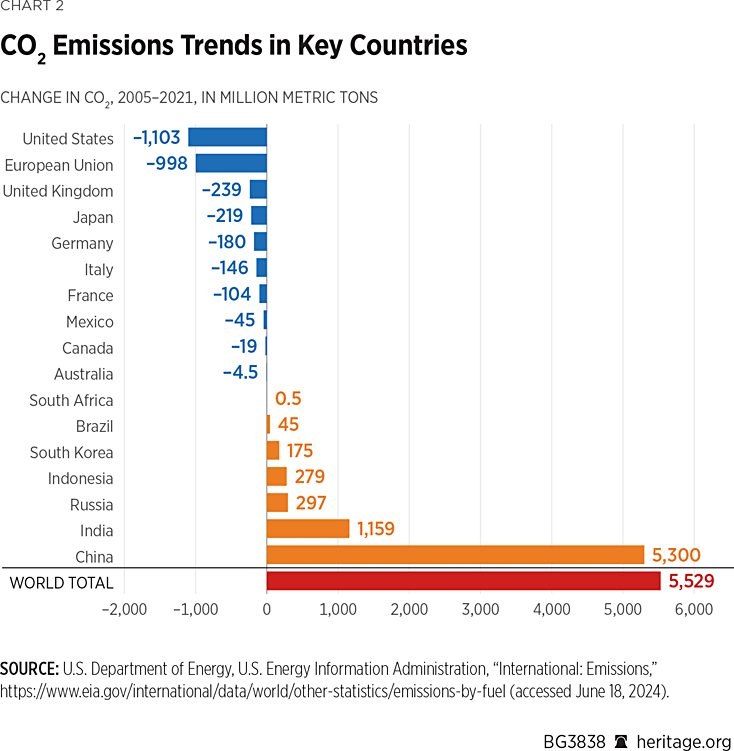
For its part, the Jones Act has not delivered on its mandate to ensure that America has a minimum of domestic shipping and merchant mariners to sustain the nation in war. In addition to the lack of needed shipping noted earlier, the 2019 Turbo Activation exercise demonstrated that only 64 percent of MARAD’s aged Ready Reserve Fleet was able to deploy on time.REF Furthermore, the act’s mandate that only U.S.-crewed and U.S.-produced ships may conduct shipments between U.S. ports has been unworkable for years. Too often, ships that conform to the Jones Act and that can move fuels, such as liquified natural gas (LNG), are not available, which means that waivers for foreign shipping are needed.REF This exacerbates an underlying mismatch between the amount of fuel that America would need and moving it to where it is needed to fight—and win—a possible war with China.REF The best approach would be to allow allied shipping to more readily participate in this domestic energy shipping while focusing on regaining American maritime competitiveness to rebuild domestic maritime capacity.REF
Wartime Energy Needs and Overseas Supply
New England’s recent diesel supply issues reflect wider inadequacies in U.S. energy policies. In wartime, the result could be a dangerously inadequate supply that is unable to meet U.S. wartime needs. Following Russia’s invasion of Ukraine, the U.S. accelerated its move away from Russian petroleum imports. At the time, Russian petroleum imports represented America’s third largest source of imported crude oil and petroleum products.REF In 2021, Russia accounted for 7.9 percent of all U.S. petroleum imports; this would drop to 17.8 million barrels a day or 6.8 percent in March before zeroing out by May 2022.REF
Without the normal influx of those Russian imports, the U.S. has been forced to find alternative sources in the global market. This move added to the already increasing price of gasoline and diesel fuel as a result of policies implemented by the Biden Administration. From inauguration day in January 2021 to the eve of Russia’s invasion in February 2022, the price of gasoline increased by 48 percent, and the price of diesel rose by 49 percent.REF Moreover, from early December 2022 through February 2023, European Union sanctions on Russian oil and petroleum products began to depress energy imports from Russia.REF
The result of these policy decisions has been a tightening of fuel markets that is driving buyers to find new suppliers to meet global demand while trying to avoid falling afoul of sanctions on such countries as Iran, Venezuela, and Russia.REF Confronted by the prospect of a shortfall in natural gas supplies, the European Union responded with mandatory reductions in energy use.REF Yet even after two years of sanctions, Russian fuel (that is, LNG) remains a critical source for 15 percent of Europe’s energy needs, underscoring Europe’s limited ability to secure alternative sources.REF Things have only grown worse as the Houthis in Yemen have been attacking shipping as it passes through the strategically important Bab el-Mandeb Strait.REF In turn, extended high energy prices add to existing inflationary pressures on wider consumer prices.
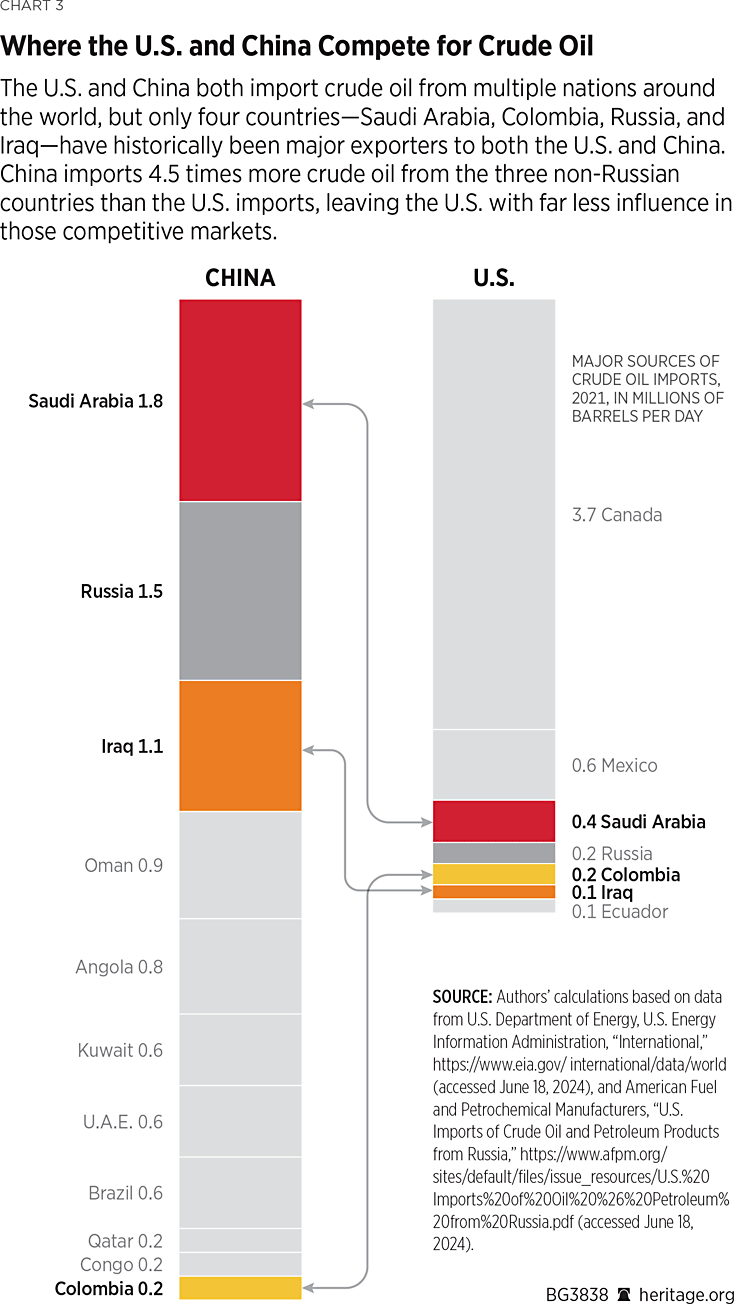
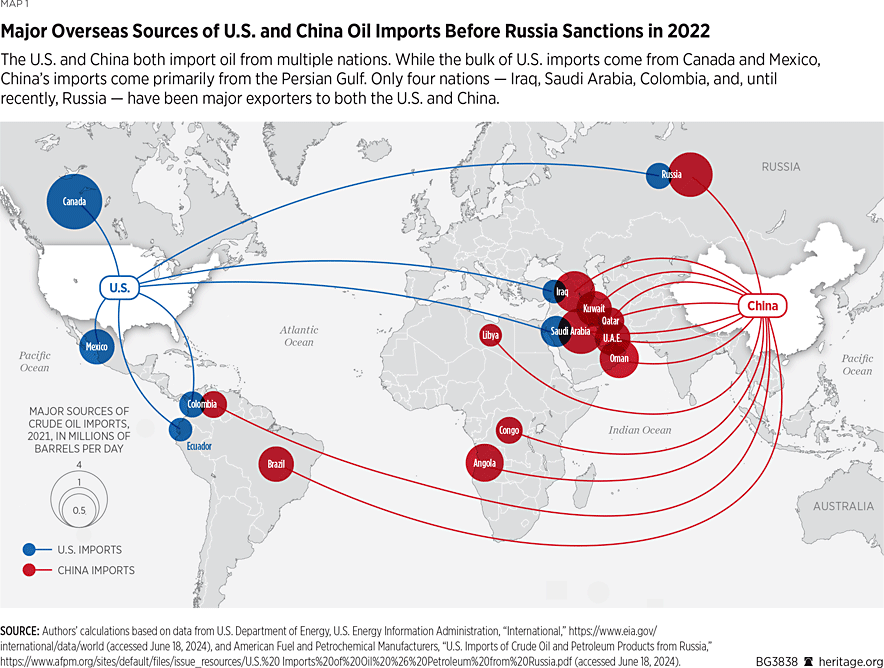
Additionally, during the COVID pandemic, low fuel demand and consumption contributed to major financial setbacks among refineries. Making matters worse, the Environmental Protection Agency’s Renewable Fuel Standard mandated that “biofuels be blended into gasoline and diesel fuels.”REF This requirement burdened refineries with compliance costs that added downward pressure on U.S. refining capacity. Eventually, five U.S. refineries were permanently closed, shrinking overall capacity.REF
The U.S. military typically procures about half of its fuel from foreign sources to sustain deployed units.REF In peacetime, sourcing fuel overseas near where it is needed makes good business sense. In war, however, this might not be viable, especially if ports in East Asia became inaccessible due to Chinese long-range strikes or nations refusing U.S. deliveries out of fear of Chinese reprisals.
Importantly, jet fuel is used not only for aircraft, but also for the gas turbines that power many American and allied warships,REF and diesel fuel in several varieties is the energy that propels large logistics ships that would serve as the commercial shipping needed during an allied war effort to move material to the front lines. According to the United Nations and the International Maritime Organization, the world’s commercial fleet of almost 54,000 large (greater than 1,000 gross weight tons) vessels carried 10.6 billion tons of cargo in 2020,REF Moving this cargo required more than 27 million tons of fuel, such as diesel fuel or gas, worldwide. Carbon-zero or net-zero initiatives are currently suppressing investments that would increase global refining capacity. Nevertheless, according to the EIA, global refining capacity grew by a million barrels a day in 2022 and was expected to reach 1.6 million barrels a day in 2023 as new refineries in Southeast Asia and the Middle East came online.REF
The EIA has assessed that global refining capacity is expected to top out at 105.2 million barrels a day by 2030.REF This growth, however, is not matching demand for refined fuels, which according to the EIA grew by 2.2 million barrels a day in 2022 and was projected to grow by 1.9 million barrels a day in 2023.REF This situation, if it persists, conceivably would make it harder and more expensive for existing ships to source needed fuel until newer, greener merchant ships come to market, though such ships are not expected to be constructed until the 2030s.REF In the meantime, there is no consensus on what this new fuel will be and how it can economically be transitioned to use by merchant ships. In total, it is estimated that the transition will cost $3 trillion and take decades to accomplish.REF
The Dilemma of Refining Capacity and Transport
Petroleum refineries, whether at home or abroad, make products such as transportation fuels or heating oil processed from crude oil. In 2023, there were 124 U.S. operating petroleum refineries. Five were idle with an operable crude distillation capacity to process 18.1 million barrels of crude oil per day.REF That is almost a million barrels less than the 19 million barrels per day in 2020 when refining capacity began a downward trajectory that has yet to be reversed in a sustained manner.REF According to the EIA, as of June 14, 2024, there were 132 refineries in operation with none idled to meet surge demand capacity.
American fuel security is a function of oil and gas production, trade relationships, transportation, pipeline infrastructure, refineries, and inventories. This will not change, according to the EIA’s International Energy Outlook: At least through 2050, there is no scenario in which global demand for fossil fuels does not increase even if there is no new conflict.REF This new demand places strain on overseas stocks as most American refineries are tuned to processing “heavy” crude oil.REF Unfortunately, the current political environment in the U.S. discourages market responses to surges in demand.
In 1949, there were 336 functioning oil refineries in the United States operating at a utilization rate of 89 percent and capable of refining 6.2 million barrels per day.REF While not a consistent decline, the number of American refineries has fallen every decade since then as remaining refineries have grown in capacity.REF This decline has resulted in greater reliance on fewer refineries to produce more refined petroleum. The benefit of economies of scale with fewer and larger refineries is geographically concentrating U.S. refining capacity. A lesson of the strategic bombing campaigns during World War II and bombing campaigns during the Vietnam War was that the energy industry’s tendency to concentrate refining sites makes it easier for an adversary to target (cyber, sabotage, etc.) with greater probability of significant operational impact.REF Such risks should be considered, although consolidation is not inherently a bad thing if it is driven by organic market pressures. In recent years, however, consolidation has been driven by harmful energy policies. As seen in California and the Northeastern United States, policy choices are affecting refining capacities.
Crude oil refinery capacity fell at the beginning of 2021 to the lowest level in the United States since 2015 with refineries closing, downsizing, or converting to renewable fuels.REF In addition, national refining capacity is not evenly distributed. In the East Coast region (PADD-1), there is little refining capacity. Today, there are only eight refineries on the whole East Coast and no operating U.S. refineries northeast of Pennsylvania.REF Moreover, there is inadequate pipeline capacity north of Pennsylvania. As a result, by the fall of 2022, inventories reached lows not seen for that time of year since 1974 when the EIA began to collect inventory data.REF The decline in inventories has resulted in the region’s being reliant on overseas suppliers—even when the U.S. became a net energy exporter in 2019.REF Altogether, in wartime or in a crisis, global trends in refinery capacity and inventories will constrain access to or markedly increase the costs of supplying the energy that the military needs.
Additionally, non-market forces such as sanctions, untold amounts of red-tape, and decarbonization regulations have discouraged the investment needed to sustain today’s refining capacity and meet future energy needs. As a result, net global refining capacity fell in 2021 for the first time in three decades.REF Roughly two-thirds of these losses occurred outside the U.S.REF
The International Energy Forum notes that “[s]ince March 2020, global refining capacity has fallen by 3.8 mb/d [million barrels per day], while global demand has grown by 5.6 mb/d.”REF However, very little investment is occurring in the U.S. or Europe where net-zero climate policies designed to force the phaseout of oil production and use are in place or being pursued. Refinery capacity in the U.S. fell again in 2023 following the closure of Lyondell Bassel, a century-old 268,000 barrels-per-day refinery in Houston, to achieve “decarbonization goals.”REF
This drop was expected to be partially offset as the nearby new Beaumont refinery reached its notional refining capacity of 250,000 barrels a day by the end of March 2023.REF Despite an abundance of domestic oil, which serves as a competitive advantage for refineries by reducing costs and maintaining high utilization rates,REF there are no plans for any new large refineries in the United States.REF Any plan for new refineries will have to account for the decade it will likely take to build and begin operations.
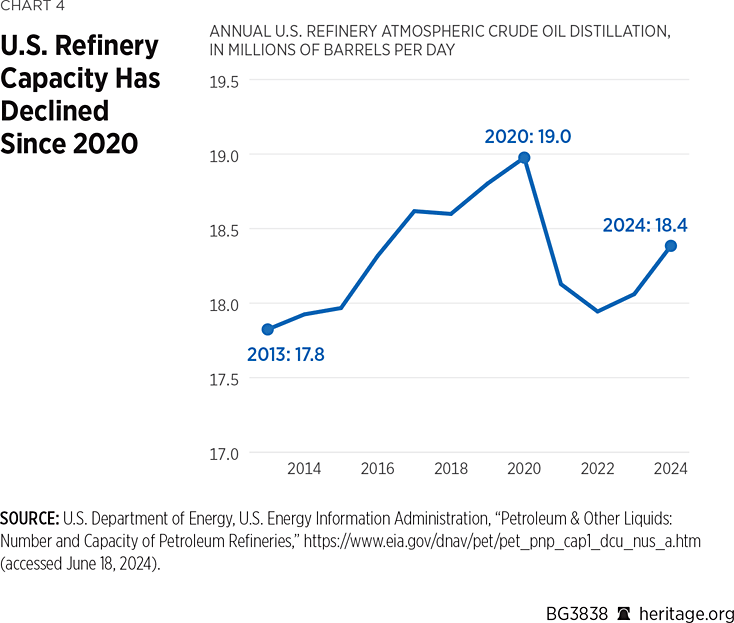
Moreover, a decrease in U.S. refining capacity directly impacts the extent to which and how quickly America can meet surging diesel, gasoline, and jet fuel demand in a prolonged conflict. In the United States, the gasoline used at the pump typically consists of 10 percent ethanol,REF which is produced as a renewable fuel additive. According to EIA data, 95 percent of national ethanol production in 2021 came from corn to be used as blendstock for oxygenate blending (BOB).REF For this reason, ethanol production is centered in the midwestern United States where there is abundant corn farming.REF Due to ethanol’s oxygen scavenging properties, its blending with pure gasoline typically occurs near to the customer, and it is shipped on trains, barges, or trucks using containers to avoid potential contamination. The U.S. exceeds its ethanol needs and meets its gasoline needs, but it also imports ethanol from Brazil to California because of the state’s Low Carbon Fuel Standards, giving it a more favorable rating over domestic corn-based ethanol.REF
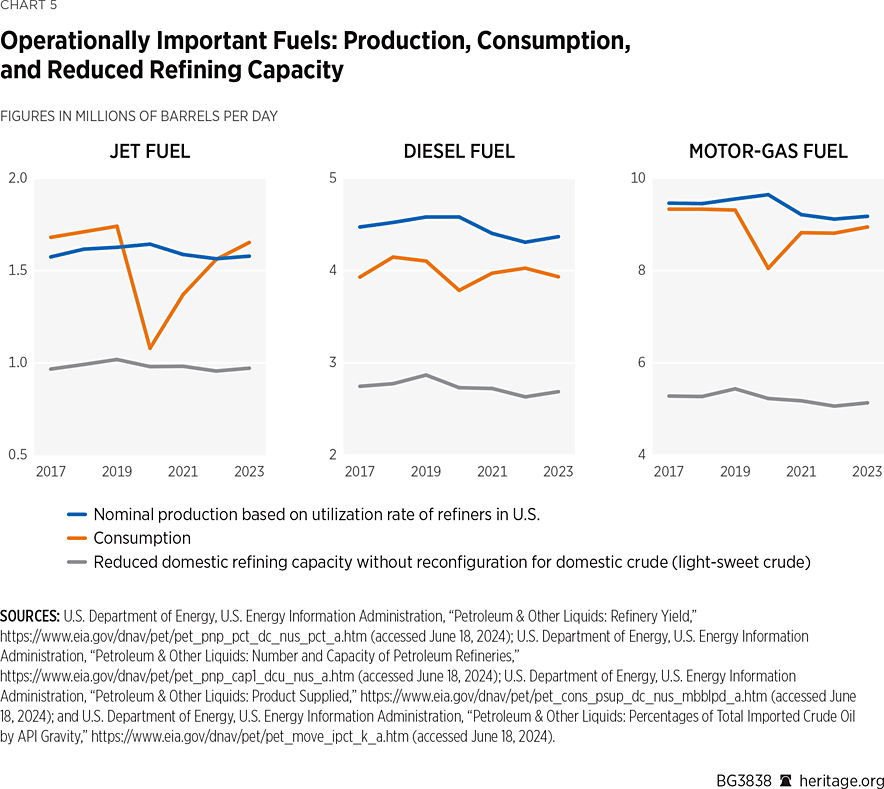
The process used for jet fuel and diesel production is less complex, which makes assessments more straightforward. Jet fuel consumption led production prior to 2020 but reversed during the COVID pandemic. Demand matched production in 2022 but was expected to widen further with the return of pre-pandemic levels of demand.REF Although diesel consumption levels have been lower than production in recent years, the margin is narrowing.REF
Overall, consumption nearly matches production of these three militarily useful fuels. Achieving this balance in 2022 involved importing crude oil (predominantly heavy crude oil) at a rate of 6.3 million barrels a day to match domestic refining needs.REF However, if overseas sources of heavy crude oil were disrupted and American refineries were forced to refine more domestic light sweet crude, production rates would falter, upsetting the current balance between production and consumption. Moreover, in a war, states such as California and those in New England that have limited refining capacity and are not well connected to domestic sources of fuels could face severe disruptions.
What the United States Needs to Do
Ensuring America’s wartime needs for energy requires adequate domestic production and transportation to get energy where it is required. Because U.S. infrastructure is inadequate for peacetime needs as well, this also means addressing present shortfalls by securing access to overseas producers and appropriate shipping. The United States therefore needs to:
- Ensure that its military has access to the necessary secure and readily available energy for a prolonged war with China.
- Determine national wartime energy needs. The Secretary of Defense must identify the minimum level of reserves in diesel, gasoline, and jet fuel needed to meet national wartime needs. Priority consideration should be given to ensuring adequate energy stockpiles as new sources and means of production are found while sustaining combat operations. In conjunction with this assessment, the Secretary of Defense should estimate the national wartime industrial energy needed to support military operations, as well as defense industrial production, as a national wartime energy baseline. Gasoline, diesel fuel, and jet fuel, unlike crude oil, are challenging to store, which is partly why the U.S. does not maintain strategic reserves of these fuels. This reality would require some level of domestic refining capacity for these fuels to be geographically distributed to process crude reserves in the event of a war with China.
- Produce periodic national energy production health reports. In consultation with the Secretary of Defense, the Secretary of Energy and the Energy Information Administration should provide Congress with a quarterly report on the adequacy of domestic energy production, transportation, and provisions for military use. The report would include an assessment of the adequacy of transportation, inventories, and the time it would take to transition existing refineries to produce militarily useful fuels from domestic crude oil sources if overseas sources were to be disrupted. This would in turn inform recommendations for adjusting the size of the SPR. As domestic crude production increased and compatible domestic refinery capacity increased, the SPR could be reduced when the margin for meeting a national wartime energy need narrowed or was erased.
- Ensure that America has the capacity to meet and sustain national energy needs in the transition from crisis to major war.
- Update SPR legislation to reflect today’s security environment. Congress should review existing legislation concerning the management of America’s SPR. Today’s reserve does not function to meet national or military needs for various types of fuels in a prolonged war. Given China’s global influence on markets and ability to interfere with U.S. access to overseas energy, new legislation is needed to address this reality. Future strategic reserve legislation should ensure that the nation has robust access to energy markets in peacetime and during times of conflict, this requires adequate fuel reserves and refinery capacity so that it cannot be coerced by China. This necessarily includes limits on the negative elements of so-called ESG influence.
- Unshackle American refiners. Global refining capacity is being artificially suppressed by net-zero and ESG policies, yet demand for petroleum will persist and become acute in wartime. The President and Congress should therefore work together to remove regulations that are meant to suppress investment in cleaner and efficient domestic petroleum refining.
- Tap into America’s vast reserves of petroleum. The President should approve the expansion of domestic oil drilling on federal lands and direct purchases over time of domestic crude oil to restock the SPR to levels informed by the gap between domestic petroleum production and the need to meet military industrial and operational wartime needs.
- Remove barriers that impede the connection of domestic energy production to customers. The examples of New England and California point to the need for more pipelines to move energy across the country safely and confidently. The need for pipelines is made more acute by the persistent shortage of U.S.-flagged tankers to move fuels during a crisis.
- Secure stronger foreign assurances of wartime provisions of fuel to the military. The Secretary of State and Secretary of Commerce should pursue agreements with important crude oil–producing and refined petroleum–producing nations to ensure energy supplies during conflict. Currently, the Defense Logistics Agency has memoranda of understanding with several nations regarding the provision of petroleum products to the military,REF and these should be reviewed with an eye to raising them to the status of treaty obligations. In concert with this effort, agreements are needed with key shipping firms and their parent governments to ensure delivery during conflict.
- Strengthen energy trade relationships with U.S. allies and partners.
- Ease the Jones Acts waiver process. Congress should either eliminate recent changes that have made Jones Act waivers more difficult or, preferably, lift such requirements altogether.REF
- Exempt treaty allies from Jones Act restrictions. Congress should ease Jones Act restrictions by allowing ships that are registered, flagged, and crewed by defense treaty allies such as Japan, the Philippines, and South Korea to provide services between U.S. ports.
- Prioritize energy resilience diplomacy, not net-zero and ESG objectives. The President should refocus diplomatic and economic engagement away from a myopic ESG and climate agenda to an agenda that supports energy resilience. Countries in Latin America, Africa, Eastern Europe, and Southeast Asia are home to burgeoning energy resources but susceptible to investment from China and Russia—both of which are known to weaponize energy markets for political control.REF
- Get out of the way of North American energy interconnections. The President should pursue policies that strengthen energy trade across North America. Canada and Mexico are the United States’ two largest energy trading partners but face unnecessary constraints.REF A first step toward alleviating this would be to permit cross-border energy infrastructure projects such as the Keystone XL pipeline. This would make it easier and less bureaucratic for investments to flow more easily to support the expansion of domestic port facilities for the trade in energy.
Conclusion
The U.S. energy network is brittle in some regions and unable to adjust easily to surges in demand. In wartime, the consequences of such weaknesses could be an inability to sustain military combat operations and the inability of wartime industry to keep America safe. On the other hand, readiness for this possibility could be a significant advantage that deters China by presenting it with a foe that is able to wage a prolonged war backed by a resilient wartime economy and industry. At the same time, an America that is self-reliant for its operational energy needs would be in a stronger overall strategic position against a China that is reliant on imports of foreign fuels.
Brent D. Sadler is Senior Research Fellow for Naval Warfare and Advanced Technology in the Douglas and Sarah Allison Center for National Security at The Heritage Foundation.




